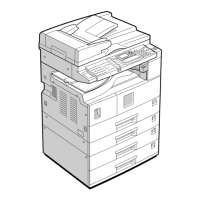Using the Installation Shell Script
11
1
❖
❖❖
❖ Making the log file
Error messages are logged to a file created in the /var/log directory. The log
file name is the printer name followed by “d-errs”.
Note
❒ The log file is used for logging errors or warning messages by the UNIX
workstation.
❒ The log file should be made for every network printer listed in the
/etc/printcap file.
❒ The log file should normally be made under /var/log directory and the
name should match that listed under the lf capability in /etc/printcap.
Change the owner and group of the log file to "root" and "lp". The follow-
ing examples show how to make a /var/log/npd-errs file:
# cd /var/log
# touch npd-errs
# chown root npd-errs
# chgrp lp npd-errs
Solaris
❖
❖❖
❖ Adding the IP address and host name to the /etc/hosts file
The following line is added to the /etc/hosts file. The IP address and printer
host name previously entered in the installation script will be used.
192.168.15.16 nphost # Network Printer
•“192.168.15.16” is the IP address. “nphost” is the host name. From # to the
end of the line is the comment.
Note
❒ The /etc/hosts file contains a list of IP addresses and names of all hosts
communicating on the network. Each entry is delimited with a space or a
tab, and each line is separated with a return.
❒ If you do not use NIS or DNS, you must enter the IP address and host name
of each workstation using the network printer in the /etc/hosts file.
❖
❖❖
❖ Registering the printer
The installation shell script registers the printer as a remote printer using the
procedure below:
A
If your workstation is Solaris 2.5.1, register the print server and print client
to the print service.
# lpsystem -t bsd -R 0 -y ″
″″
″Network Printer″
″″
″ nphost

